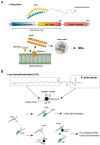Lysophospholipids: A Potential Drug Candidates for Neurodegenerative Disorders
- PMID: 36551882
- PMCID: PMC9775253
- DOI: 10.3390/biomedicines10123126
Lysophospholipids: A Potential Drug Candidates for Neurodegenerative Disorders
Abstract
Neurodegenerative diseases (NDs) commonly present misfolded and aggregated proteins. Considerable research has been performed to unearth the molecular processes underpinning this pathological aggregation and develop therapeutic strategies targeting NDs. Fibrillary deposits of α-synuclein (α-Syn), a highly conserved and thermostable protein, are a critical feature in the development of NDs such as Alzheimer's disease (AD), Lewy body disease (LBD), Parkinson's disease (PD), and multiple system atrophy (MSA). Inhibition of α-Syn aggregation can thus serve as a potential approach for therapeutic intervention. Recently, the degradation of target proteins by small molecules has emerged as a new therapeutic modality, gaining the hotspot in pharmaceutical research. Additionally, interest is growing in the use of food-derived bioactive compounds as intervention agents against NDs via functional foods and dietary supplements. According to reports, dietary bioactive phospholipids may have cognition-enhancing and neuroprotective effects, owing to their abilities to influence cognition and mental health in vivo and in vitro. However, the mechanisms by which lipids may prevent the pathological aggregation of α-Syn warrant further clarification. Here, we review evidence for the potential mechanisms underlying this effect, with a particular focus on how porcine liver decomposition product (PLDP)-derived lysophospholipids (LPLs) may inhibit α-Syn aggregation.
Keywords: amyloid; lysophospholipids; neurodegenerative diseases; α-synuclein.
Conflict of interest statement
All authors have no conflicts of interests to declare.
Figures


Similar articles
-
Lysophospholipids-potent candidates for brain food, protects neuronal cells against α-Synuclein aggregation.Biomed Pharmacother. 2022 Dec;156:113891. doi: 10.1016/j.biopha.2022.113891. Epub 2022 Oct 18. Biomed Pharmacother. 2022. PMID: 36265307
-
Lysophosphatidylcholine binds α-synuclein and prevents its pathological aggregation.Natl Sci Rev. 2024 May 25;11(6):nwae182. doi: 10.1093/nsr/nwae182. eCollection 2024 Jun. Natl Sci Rev. 2024. PMID: 38962715 Free PMC article.
-
Plant Extracts and Phytochemicals Targeting α-Synuclein Aggregation in Parkinson's Disease Models.Front Pharmacol. 2019 Mar 19;9:1555. doi: 10.3389/fphar.2018.01555. eCollection 2018. Front Pharmacol. 2019. PMID: 30941047 Free PMC article. Review.
-
α-Synuclein Heteromers in Red Blood Cells of Alzheimer's Disease and Lewy Body Dementia Patients.J Alzheimers Dis. 2021;80(2):885-893. doi: 10.3233/JAD-201038. J Alzheimers Dis. 2021. PMID: 33579836
-
Distinct α-Synuclein strains and implications for heterogeneity among α-Synucleinopathies.Neurobiol Dis. 2018 Jan;109(Pt B):209-218. doi: 10.1016/j.nbd.2017.07.018. Epub 2017 Jul 24. Neurobiol Dis. 2018. PMID: 28751258 Free PMC article. Review.
Cited by
-
Phospholipidomics in Clinical Trials for Brain Disorders: Advancing our Understanding and Therapeutic Potentials.Mol Neurobiol. 2024 Jun;61(6):3272-3295. doi: 10.1007/s12035-023-03793-y. Epub 2023 Nov 20. Mol Neurobiol. 2024. PMID: 37981628 Free PMC article. Review.
References
Publication types
Grants and funding
LinkOut - more resources
Full Text Sources
Miscellaneous

